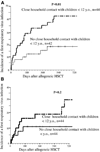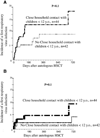Prospective study of the incidence, clinical features, and outcome of symptomatic upper and lower respiratory tract infections by respiratory viruses in adult recipients of hematopoietic stem cell transplants for hematologic malignancies
- PMID: 16182179
- PMCID: PMC3347977
- DOI: 10.1016/j.bbmt.2005.07.007
Prospective study of the incidence, clinical features, and outcome of symptomatic upper and lower respiratory tract infections by respiratory viruses in adult recipients of hematopoietic stem cell transplants for hematologic malignancies
Abstract
Respiratory viruses (RVs) are known to be major causes of morbidity and mortality in recipients of hematopoietic stem cell transplants (HSCTs), but prospective long-term studies are lacking. We prospectively screened all adult HSCT recipients (172 allogeneic [alloHSCT] and 240 autologous [autoHSCT]) who underwent transplantation during a 4-year period (1999 to 2003) for the development of a first episode of symptomatic upper respiratory tract infections and/or lower respiratory tract infections (LRTI) by an RV. RVs studied were influenza A and B viruses (n=39), human respiratory syncytial virus (n=19), human adenoviruses (n=11), human parainfluenza viruses 1 to 3 (n=8), human enteroviruses (n=5), human rhinoviruses (n=3), and the recently discovered human metapneumoviruses (n=19). During the study, 51 and 32 cases of RV symptomatic infections were identified of alloHSCT and autoHSCT recipients (2-year incidence, 29% and 14%, respectively). Risk factors for progression of upper respiratory tract infection to LRTI included severe (<0.2x10(9)/L) and moderate (<0.2x10(9)/L) lymphocytopenia in alloHSCT (P=.02) and autoHSCT (P=.03). Death from LRTI was attributed to an RV in 8 alloHSCT recipients. Symptomatic RV had no effect on 2-year outcomes, with the possible exception of influenza A and B virus infections in autoHSCT: these were associated with nonrelapse mortality (P=.02). In conclusion, this prospective trial allows an estimation of the minimum incidence of a first RV infection in adult HSCT recipients and identifies risk factors for acquisition of an RV infection and progression to LRTI; this should aid in the design of future studies. In addition, human metapneumovirus should be added to the potentially serious causes of RV infections in HSCT.
Figures


References
-
- Nichols WG, Guthrie KA, Corey L, Boeckh M. Influenza infections after hematopoietic stem cell transplantation: risk factors, mortality, and the effect of antiviral therapy. Clin Infect Dis. 2004;39:1300–1306. - PubMed
-
- Nichols WG, Gooley T, Boeckh M. Community-acquired respiratory syncytial virus and parainfluenza virus infections after hematopoietic stem cell transplantation: the Fred Hutchinson Cancer Research Center experience. Biol Blood Marrow Transplant. 2001;7(suppl):11S–15S. - PubMed
-
- Nichols WG, Corey L, Gooley T, Davis C, Boeckh M. Parainfluenza virus infections after hematopoietic stem cell transplantation: risk factors, response to antiviral therapy, and effect on transplant outcome. Blood. 2001;98:573–578. - PubMed
-
- Whimbey E, Champlin RE, Couch RB, et al. Community respiratory virus infections among hospitalized adult bone marrow transplant recipients. Clin Infect Dis. 1996;22:778–782. - PubMed
Publication types
MeSH terms
Grants and funding
LinkOut - more resources
Full Text Sources
Other Literature Sources

